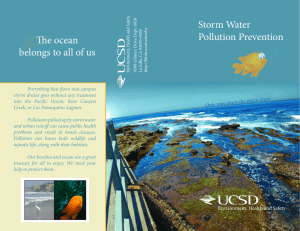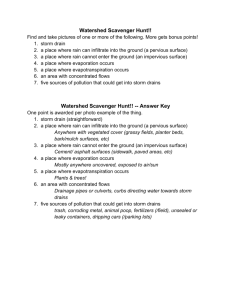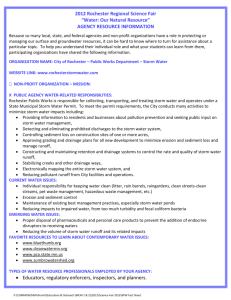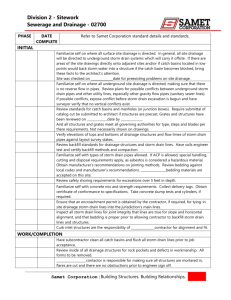File
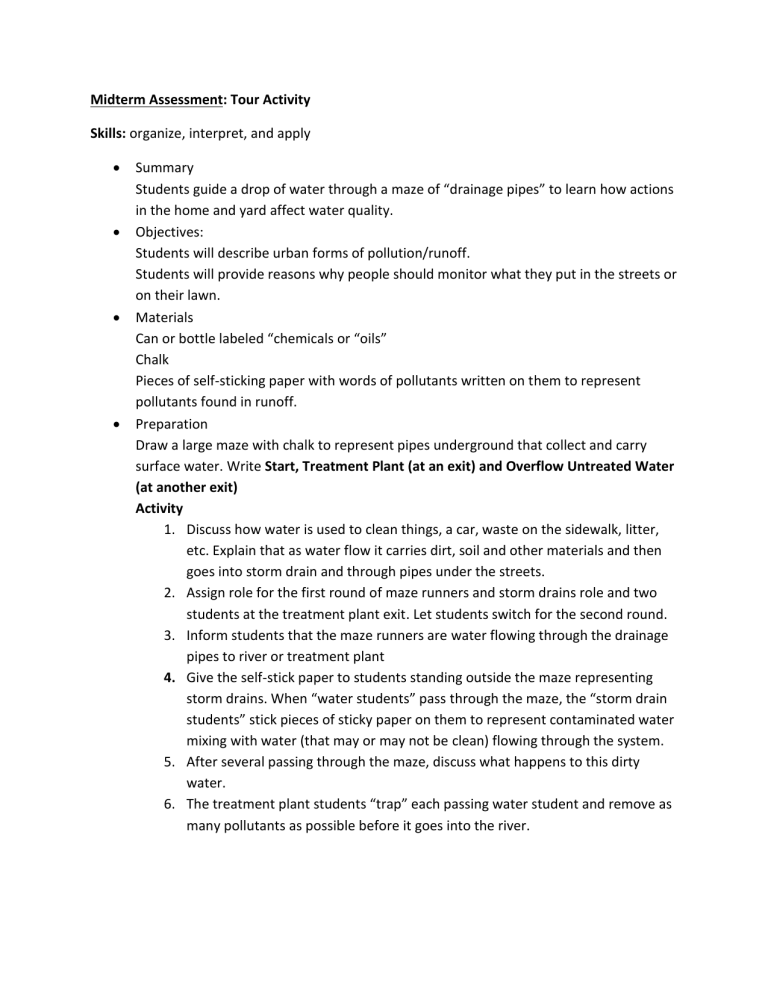
Midterm Assessment: Tour Activity
Skills: organize, interpret, and apply
Summary
Students guide a drop of water through a maze of “drainage pipes” to learn how actions in the home and yard affect water quality.
Objectives:
Students will describe urban forms of pollution/runoff.
Students will provide reasons why people should monitor what they put in the streets or on their lawn.
Materials
Can or bottle labeled “chemicals or “oils”
Chalk
Pieces of self-sticking paper with words of pollutants written on them to represent pollutants found in runoff.
Preparation
Draw a large maze with chalk to represent pipes underground that collect and carry surface water. Write Start, Treatment Plant (at an exit) and Overflow Untreated Water
(at another exit)
Activity
1.
Discuss how water is used to clean things, a car, waste on the sidewalk, litter, etc. Explain that as water flow it carries dirt, soil and other materials and then goes into storm drain and through pipes under the streets.
2.
Assign role for the first round of maze runners and storm drains role and two students at the treatment plant exit. Let students switch for the second round.
3.
Inform students that the maze runners are water flowing through the drainage pipes to river or treatment plant
4.
Give the self-stick paper to students standing outside the maze representing storm drains. When “water students” pass through the maze, the “storm drain students” stick pieces of sticky paper on them to represent contaminated water mixing with water (that may or may not be clean) flowing through the system.
5.
After several passing through the maze, discuss what happens to this dirty water.
6.
The treatment plant students “trap” each passing water student and remove as many pollutants as possible before it goes into the river.
Assessment
Questions to ask:
Can treatment plants process all waste?
Have students talk about the effects of litter on the water system?
What do you think about the quality of this water passing into the river?
Pre-Tour Lesson
Speaking and listening Standard 6.1C
Objective
Students will be able to describe forms of pollution in an urban setting.
Procedure
Introduce vocabulary: contaminants, pollutants, runoff, and storm drain
Show students a bottle labeled “chemicals” or “oil” tell students you need to get rid of its content and plan to dump it in front of the school. Ask the students if they think it’s a good idea.
Have student use Think-Pair and Share to describe what they think will happen to the waste material.
Materials (Differentiation)
Pictures of flooding, litter on the street, storm drain and water sources
Making Connections
Most students are familiar with urban litter found in urban settings, car oil stains, litter, animal waste, paint, etc., all wash down storm drains. Investigating what happens to these materials after they enter drainage systems helps students understand how these materials can affect water supplies and aquatic plants and animals.
Background
Removing water quickly and efficiently from city streets, school yards and lots after it rains or after a snowstorm is an important task for local government. Explain that before storm drains were common, cities experienced flooding. Not having a storm system or when one over flows can cause serious health problems and safety concerns that need to be solved.
In the past, water that went into the storm system received little or no treatment at all before flowing back into a stream or body of water. It was found that water draining off sidewalks, driveways, parking lots, lawns and streets carried many pollutants. These pollutants included pesticides, animal waste, motor oil, litter and other contaminants.
Natural bodies of water were polluted and animals and plants were affected. The solution was to channel storm runoff into wastewater treatment plants.
Assessment
Discussion and questions session to informally gage students understanding of the topic.
